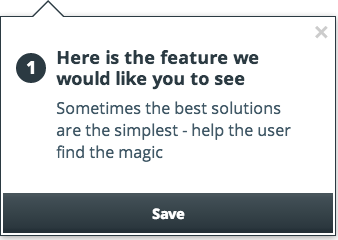The worlds of user experience (UX), customer experience (CX), service design, even growth-hacking are littered with philosophies and sophistries on how to gain incremental, small percentage gains in user conversion and/or retention. Millions of dollars and hours are spent engaging and re-engaging experience architects to make features and products discoverable. Millions more are lost on attracting and then losing users who fail to find what it is the company wanted them to discover.
No-one sensible can dispute that these efforts are important. As consumers and users we have all been on the wrong side of an online experience that we have found simply baffling. On the industry side it is amazing how often we hear marketers and product managers bemoan the unfound product, the unused product feature or the need to answer the same questions time and time again.
But rather than going immediately back to the design blackboard to improve the user journey or investing yet more resource in answering non-productive questions is it too simple to ask
why don’t you simply point the user or customer in the right direction?

Are pointers bad design?
Well it is a highly-charged topic: take this recent tweet from a highly respected usability design agency:

A UI should be invisible? Always?
Let’s be clear – there is no excuse for a carelessly designed and confusing interface (I don’t think anyone builds a confusing one deliberately except maybe the government). There is also no substitute for thinking very carefully about the user experience and making it as straightforward as possible.
But sometimes, actually quite often, there is just no getting around the fact that there is a lot of information to convey on a particular screen, there may be a lot of features to a product that need space, or there might simply be a significant number of steps to follow to complete a process. I would love my tax return to be a one click process – but it ain’t going to happen.
So how should we consider interactive guides as part of the customer experience?
Well let’s deal with the resistance to using them first. There is a clearly a cultural resistance amongst people who create these experiences to adding ‘signposts’ to their work. As you can see from that tweet, this can be fairly hard-wired. But really the best way to look at it is another tool in the armoury of people whose passion is getting the user experience right.
For instance, Slack is a product that is causing an adoption sensation and largely amongst companies and teams that are typically concerned with designing and creating online experiences for customers. It is lauded for its ease of use and yet for any first time users are a series of pointers, highlighting features that the users know are critical for user adoptions and success.

Guides created by people who care about the users – that's next gen
The most common point of resistance though is the practical one. Getting guides on to websites, or into products very often becomes the responsibility of either the product or web development teams. As anyone who has spent 5 minutes in a business will be aware getting priority on these teams for anything is not so simple. But even if you can it is the ability to iterate and adapt the guides that is the key to their success. so many attempts die on the vine due to an inability to get them prioritised for trial, to an inability to change them quickly based on a change in process or as importantly, based on feedback from the users as to how they are using the guides.
Tools therefore like Nickelled put the guides where they belong – in the hands of the people who build the experience. We believe that this is what defines the step change between this approach and the generations that preceeded it.
If you can type and point a cursor you can build, deploy and test a Nickelled guide in minutes. This is the most powerful way for these guides can find their place in the customer and user experience process. No skills outside of the key one – an understanding of the product or service that you provide – are needed.
Next generation interactive guides
So the questions remains – are you ignoring what might be the simplest change that you can make to your service of product in 2015 that will have the biggest impact on user experience? Are we leaving these potential superstars on the bench and with them their game-changing potential for your business?
We will be sharing regular thoughts and updates through this blog and on other channels on where we see these simple guides making a significant impact for our customers and across the industry generally. We’d love you to subscribe to the blog or follow us (@nickelledapp) on Twitter and contribute to this discussion as it develops.